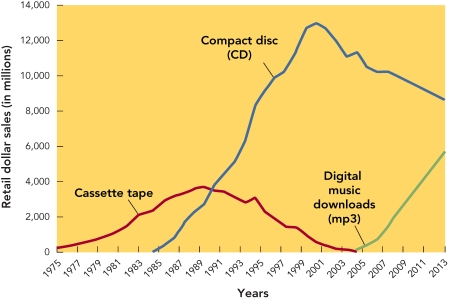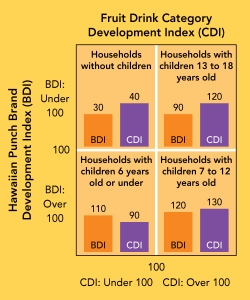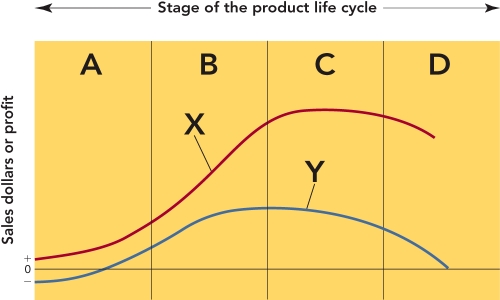A) product line; product class
B) product family; product line
C) product class; product form
D) product brand; product line
E) product form; product class
G) A) and E)
Correct Answer

verified
Correct Answer
verified
Multiple Choice
a firm's marketing dashboard displays a CDI under 100 for a consumer packaged good,such as General Mills' Warm Delights Minis,this indicates which of the following?
A) a weak brand position in a segment
B) a strong brand position in a segment
C) above-average product category purchases by a market segment
D) below-average product category purchases by a market segment
E) There is not enough information to make any conclusions.
G) C) and D)
Correct Answer

verified
Correct Answer
verified
Multiple Choice
Managers often use two special indexes to help identify strong and weak market segments in order to provide direction for marketing efforts.The two indexes,CDI and BDI,stand for __________.
A) comprehensive demographic inventory and brand designation information
B) consumer demographic index and buyer demographic inventory
C) category development index and brand development index
D) consumer development index and brand development inventory
E) category development index and buyer development inventory
G) C) and D)
Correct Answer

verified
Correct Answer
verified
Multiple Choice
 Figure 11-4
-Figure 11-4 above shows that in 1995,CDs were in the __________ stage of the product life cycle,while cassette tapes were in the __________ stage.
Figure 11-4
-Figure 11-4 above shows that in 1995,CDs were in the __________ stage of the product life cycle,while cassette tapes were in the __________ stage.
A) introduction; growth
B) growth; introduction
C) maturity; growth
D) harvest; decline
E) growth; decline
G) A) and C)
Correct Answer

verified
Correct Answer
verified
Multiple Choice
A__________ product requires little learning by the consumer,and the benefits of the purchase are readily understood.
A) high-learning
B) fashion
C) fad
D) substitute
E) low-learning
G) C) and E)
Correct Answer

verified
Correct Answer
verified
Multiple Choice
 CDI/BDI Marketing Dashboard
-the CDI/BDI marketing dashboard above,which segment consumes the most fruit drinks?
CDI/BDI Marketing Dashboard
-the CDI/BDI marketing dashboard above,which segment consumes the most fruit drinks?
A) households without children
B) households with children 13 to 18 years old
C) households with children 6 years old or under
D) households with children 7 to 12 years old
E) Because the BDI and CDI show inconsistencies in their measurements, especially in the segment of children under the age of six, it is impossible to answer the question.
G) A) and D)
Correct Answer

verified
Correct Answer
verified
Multiple Choice
marketing objective for a product in the __________ stage of the product life cycle is to create consumer awareness and stimulate trial.
A) introduction
B) growth
C) maturity
D) decline
E) accelerated development
G) B) and D)
Correct Answer

verified
Correct Answer
verified
Multiple Choice
Another name for multiproduct branding is __________.
A) family branding
B) mixed branding
C) uniform branding
D) co-branding
E) agent licensing
G) All of the above
Correct Answer

verified
Correct Answer
verified
Multiple Choice
a firm's marketing dashboard displays a CDI over 100 for a consumer packaged good,such as General Mills' Warm Delights Minis,this indicates which of the following?
A) a weak brand position in a segment
B) a strong brand position in a segment
C) above-average product category purchases by a market segment
D) below-average product category purchases by a market segment
E) There is not enough information to make any conclusions.
G) A) and E)
Correct Answer

verified
Correct Answer
verified
Multiple Choice
aging baby boomer population has led to increased interest in developing and marketing products to satisfy the needs of this large market.As a result,moisturizing lotions and creams like Oil of Olay are now positioned as "age-defying" products.This is an example of which of repositioning action?
A) reaching a new market
B) reacting to a competitor's position
C) trading up
D) changing the value offered
E) product modification
G) A) and E)
Correct Answer

verified
Correct Answer
verified
Multiple Choice
 Figure 11-1
-Figure 11-1 above represents the stages of the product life cycle.What does the portion of the curve labeled "D" represent?
Figure 11-1
-Figure 11-1 above represents the stages of the product life cycle.What does the portion of the curve labeled "D" represent?
A) introduction
B) maturity
C) growth
D) accelerated development
E) decline
G) C) and D)
Correct Answer

verified
Correct Answer
verified
Multiple Choice
Which of the following products would have a fad product life cycle curve?
A) women's hosiery
B) pet rocks
C) electric cars
D) convection ovens
E) sport drinks
G) A) and D)
Correct Answer

verified
Correct Answer
verified
Multiple Choice
initial purchase of a product by a consumer is referred to as a(n) _________.
A) product sampling
B) first buy
C) trial
D) assessment
E) examination period
G) A) and D)
Correct Answer

verified
Correct Answer
verified
Multiple Choice
Procter & Gamble introduced the product manager staff position in a marketing organizational structure in 1928.Consumer packaged goods firms like General Mills and PepsiCo and as well as industrial firms such as Intel and Hewlett-Packard employ a product manager to manage __________.
A) all of an organization's product items or brands
B) all of an organization's product classes
C) all of an organization's existing products through the stages of their life cycles
D) all products or brands that require close fiscal scrutiny
E) a close-knit family of products or brands
G) B) and C)
Correct Answer

verified
Correct Answer
verified
Multiple Choice
Product form refers to __________.
A) the legal description of an individual item including all its salient characteristics
B) the SKU designation assigned to a product item
C) a series of product items that share similar characteristics in terms of usage
D) variations within the product class
E) a group of product items that comprise an industry
G) C) and E)
Correct Answer

verified
Correct Answer
verified
Multiple Choice
key challenges that package and label designers face include: (1) connecting with customers; (2) __________; (3) health,safety,and security issues; and (4) cost reduction.
A) governmental regulations
B) environmental concerns
C) competition from global markets
D) patent and trademark issues
E) cultural and societal issues
G) C) and D)
Correct Answer

verified
Correct Answer
verified
Multiple Choice
all electric-powered automobile is in which stage of its product life cycle?
A) growth
B) maturity
C) introduction
D) decline
E) accelerated development
G) C) and E)
Correct Answer

verified
Correct Answer
verified
Multiple Choice
strategy for managing a product's life cycle that attempts to increase a product's use among existing customers,create new use situations,or find new customers is referred to as __________.
A) market modification
B) product modification
C) product repositioning
D) product extension
E) diversification
G) B) and D)
Correct Answer

verified
Correct Answer
verified
Multiple Choice
Xerox pioneered the first portable fax machine.In 1980,the price was $12,700.Xerox used a(n) __________ pricing strategy to help recover its research and development costs.
A) penetration
B) cost-plus
C) target ROI
D) above-market
E) skimming
G) None of the above
Correct Answer

verified
Correct Answer
verified
Multiple Choice
product brands introduced as defensive moves to counteract and confront a firm's competition are referred to as __________.
A) co-brands
B) private brands
C) fighting brands
D) brand extensions
E) subbrands
G) B) and E)
Correct Answer

verified
Correct Answer
verified
Showing 141 - 160 of 404
Related Exams